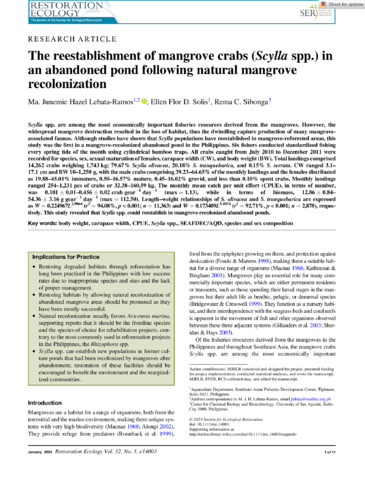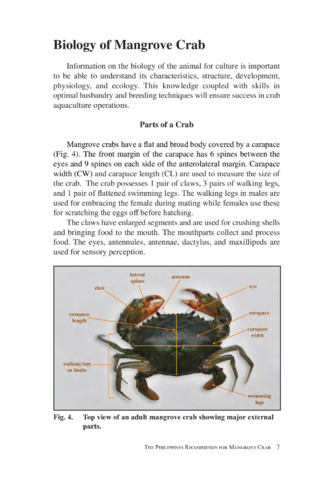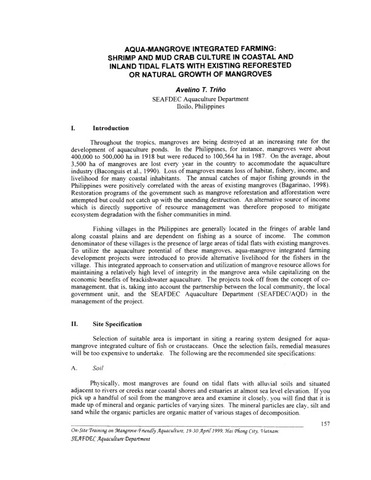The reestablishment of mangrove crabs (Scylla spp.) in an abandoned pond following natural mangrove recolonization
- Global styles
- MLA
- Vancouver
- Elsevier - Harvard
- APA
- Help

閲覧/開く
日付
2024-01Page views
1,014ASFA keyword
AGROVOC keyword
Taxonomic term
Metadata
アイテムの詳細レコードを表示する
Share
抄録
Scylla spp. are among the most economically important fisheries resources derived from the mangroves. However, the widespread mangrove destruction resulted in the loss of habitat, thus the dwindling capture production of many mangrove-associated faunas. Although studies have shown that Scylla populations have reestablished in mangrove-reforested areas, this study was the first in a mangrove-recolonized abandoned pond in the Philippines. Six fishers conducted standardized fishing every spring tide of the month using cylindrical bamboo traps. All crabs caught from July 2010 to December 2011 were recorded for species, sex, sexual maturation of females, carapace width (CW), and body weight (BW). Total landings comprised 14,262 crabs weighing 1,743 kg; 79.67% Scylla olivacea, 20.18% S. tranquebarica, and 0.15% S. serrata. CW ranged 3.1–17.1 cm and BW 10–1,250 g, with the male crabs comprising 39.23–64.65% of the monthly landings and the females distributed as 19.88–45.01% immature, 0.50–16.57% mature, 0.45–16.02% gravid, and less than 0.10% spent crabs. Monthly landings ranged 254–1,231 pcs of crabs or 32.38–160.59 kg. The monthly mean catch per unit effort (CPUE), in terms of number, was 0.101 ± 0.01–0.456 ± 0.02 crab gear−1 day−1 (max = 1.13), while in terms of biomass, 12.86 ± 0.84–54.36 ± 3.16 g gear−1 day−1 (max = 112.50). Length–weight relationships of S. olivacea and S. tranquebarica are expressed as W = 0.224967L2.9864 (r2 = 94.08%, p < 0.001; n = 11,363) and W = 0.173409L3.1074 (r2 = 92.71%, p < 0.001; n = 2,878), respectively. This study revealed that Scylla spp. could reestablish in mangrove-recolonized abandoned ponds.
Suggested Citation
Lebata-Ramos, M. J. H., Solis, E. F. D., & Sibonga, R. (2024). The reestablishment of mangrove crabs (Scylla spp.) in an abandoned pond following natural mangrove recolonization. Restoration Ecology , 32(1), e14003. https://doi.org/10.1111/rec.14003
Type
ArticleISSN
1061-2971; 1526-100XCollections
- Journal Articles [1258]
Related items
Showing items related by title, author, creator and subject.
-
[The Philippines recommends for mangrove crab:] Biology of mangrove crab
The Mangrove Crab Technical Committee 2018 (DOST-PCAARRD, 2021) -
Aqua-mangrove integrated farming: Shrimp and mud crab culture in coastal and inland tidal flats with existing reforested or natural growth of mangroves
Triño, Avelino T. (Aquaculture Department, Southeast Asian Fisheries Development Center, 2000)Throughout the tropics, mangroves are being destroyed at an increasing rate for the development of aquaculture ponds. In the Philippines, for instance, mangroves were about 400,000 to 500,000 ha in 1918 but were reduced ... -
Seasonal abundance, distribution and recruitment of mud crabs (Scylla spp.) in replanted mangroves
Walton, Mark E.; Le Vay, Lewis; Lebata, Junemie H. ; Binas, Joseph; Primavera, Jurgenne
; Binas, Joseph; Primavera, Jurgenne  (Elsevier, 2006)
The abundance and distribution of mud crabs were studied in a replanted mangrove forest in Buswang, Aklan, Philippines. Two fishing gears, lift nets and bamboo traps, were used to monitor relative abundance of Scylla spp. ...
(Elsevier, 2006)
The abundance and distribution of mud crabs were studied in a replanted mangrove forest in Buswang, Aklan, Philippines. Two fishing gears, lift nets and bamboo traps, were used to monitor relative abundance of Scylla spp. ...





